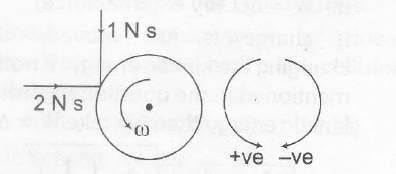Answer:
Option A,C
Explanation:
The data is incomplete. Let us assume that friction from ground on ring is not
impulsive during impact.
From linear momentum conservation in horizontal direction, we have
(2×1)+(0.1×20)=(0.1×0)+(2×v)←−v→+ve
Here, v is the ve;locity of CM of ring after impact
Solving the above equation, we have
u=0
Thus, CM becomes stationary.
∴ correct answer is (a)
Linear impulse during impact
(i) In horizontal direction
J1=△P=0.1×v20=2Ns
(ii) In vertical direction
J2=△P=0.1×10=1Ns

Writing the equation (about CM)
Angular impulse= change in angular momentum
1×(√32×12)−2×0.5×12
=2×(0.5)2[ω−10.5]
Solving this equation ω comes out to be positive or ω anti-clockwise. So just after collision rightwards slipping is taking place.
Hence, friction is leftwards.
Therefore, option (c) is also correct
Correct options are (a) and (c).